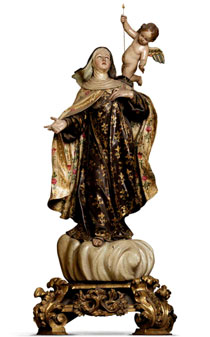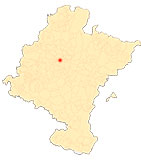pathway Teresian in Pamplona
The delicate Neapolitan sculpture in San Cernin
This A sculpture arrived from Naples in 1772 to be placed on the altarpiece of the Virgen del Camino, in her chapel in the parish of San Cernin. Its donor was Don Agustín de Leiza y Eraso, who in that year was living in Madrid, after having made a brilliant degree program in the administration. committee Don Agustín, a native of Aragón and a descendant of Navarre and son of the Marquis of Alcázar, had been mayor of the Court (1744) and ombudsman of the Royal Court of Navarre between 1755 and 1765. In the latter year he was promoted in the Spanish capital to mayor of Casa y Corte, in 1767 he became oidor of the committee de Hacienda and, in 1770, he reached one of the most important posts in the Spanish administration in the Chamber of Castile. Agustín's years in the capital of Navarre must have left him with a special devotion to the Virgin of the Way, so venerated in those central decades of the Age of Enlightenment, on the eve of the construction of her new and monumental chapel in the parish church of San Saturnino.
Despite the fact that the transverberation topic is apparently more pictorial than sculptural, it should be pointed out that there are many plastic groups, especially in the 18th century in Navarre, as evidenced by the sculptures in the sacristy of the Descalzos de Pamplona, the parish church of Huarte-Pamplona, and the main altarpiece of Araceli de Corella.
This passage in the life of the Carmelite saint is undoubtedly the most artistically represented event, based on what she herself tells us in chapter XXIX. The devotion grew to such an extent that on 25 May 1726 the Carmelite Order obtained the Holy See's permission to celebrate it with its own mass on 26 August.
The saint is depicted on a rich pedestal of leaf litter and cloud, in a visionary pose. She wears richly polychrome robes with brightly coloured bouquets, executed with brushstrokes, especially on the border of the cloak. Unlike other examples, in this case there is no trace of her attributes as a writer. The diagonal formed by her outstretched right arm and the little angel, half-kneeling on her left shoulder, adds to the rhetorical effects typical of baroque visions.
-
FERNÁNDEZ GRACIA, R., "El convento e iglesia de los Carmelitas Descalzos de Pamplona. Architecture", Príncipe de Viana, 164, 1981, pp. 787-818.
-
ECHEVERRÍA GOÑI, P. and FERNÁNDEZ GRACIA, R., "El convento e iglesia de los carmelitas descalzos de Pamplona. Exorno artístico", Príncipe de Viana, 164, 1981, pp. 819-891.
-
AZANZA LÓPEZ, J. J., Arquitectura Religiosa Barroca en Navarra, Pamplona, Government of Navarre, 1996.
-
FERNÁNDEZ GRACIA, R., El retablo barroco en Navarra, Pamplona, Government of Navarre, 2003.
-
FERNÁNDEZ GRACIA, R., The Immaculate Conception in Navarre. Art and devotion during the centuries of the Baroque Mentors, artists and iconography. Pamplona, Eunsa, 2004.
-
FERNÁNDEZ GRACIA, R., Engraving, Counter-Reformation and Teresian Carmel. The collection of engravings of the Discalced Carmelites of Pamplona and Leonor de la Misericordia (Ayanz and Beaumont). Pamplona, I. G. Castuera, 2004.
-
FERNÁNDEZ GRACIA, R., "Santa Teresa", Juan de Goyeneche y el triunfo de los navarros en la Monarquía Hispánica del siglo XVIII, Pamplona, Fundación Caja Navarra, 2005, p. 352.
-
FERNÁNDEZ GRACIA, R., "Algunas esculturas napolitanas en Navarra", Pulchrum. Scripta in honorem Mª Concepción García Gainza, Pamplona, Government of Navarre, department de Cultura y Turismo-Institución Príncipe de Viana, 2011, pp. 300-310.
-
TARIFA CASTILLA, M. J., "Aparición de Cristo a Santa Teresa", Pamplona y San Cernin 1611-2011. IV Centenary of the Vow of the City, Pamplona, Pamplona City Council, 2011, p. 176.












